Parallel Lines and Transversals
Test Review
1. Find m ⁄ Q. (The diagram is not to scale)
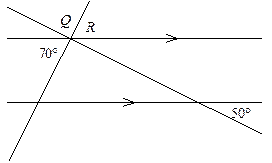
m ⁄ Q = _________________
2. Use the diagram to find the following:
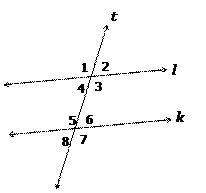
Name the postulate or theorem that proves l || k for the given
information.
Use the diagram below and the answer choices for #s 3-5.
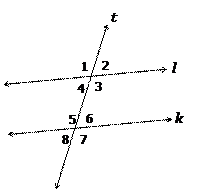
___________ 3. m ⁄ 1 = m ⁄ 7
___________ 4. m ⁄ 4 + m ⁄ 5 = 180˚
___________ 5. m ⁄ 2 = m ⁄ 6
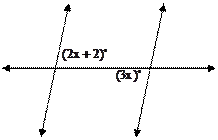 6. Solve for x
6. Solve for x
x = _____________________
7. If m ⁄ 8 = 107˚, what is the sum of the m ⁄ 1 and m ⁄ 4?
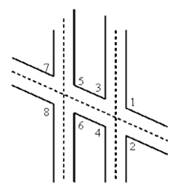
m ⁄ 1 + m ⁄ 4 = _______________________
8. Construct two parallel lines. Label line r parallel to line q
9. Using the following conditional statement
If two lines are parallel, then the corresponding angles are congruent.
Write the following:
Hypothesis (p): ___________________________________________________________________________
Conclusion (q): _______________________________________________________________________________
Converse: __________________________________________________________________________________
Inverse: ____________________________________________________________________________________
Contrapositive: ___________________________________________________________________________
Parallel Lines and Transversals
Test Review
Answer Sheet
1. m ⁄ Q = 60˚
2. Possible answers:
3. c. If two parallel lines are cut by a transversal, then the pairs of alternate
exterior angles are congruent.
4. d. If two parallel lines are cut by a transversal, then the same-side interior
angles are supplementary.
5. a. If two parallel lines are cut by a transversal, then the pairs of
corresponding angles are congruent.
6. x = 2
7. m ⁄ 1 + m ⁄ 4 = 214˚
8. See printed out notes I gave you on constructing parallel lines.
9. Hypothesis (p): two lines are parallel
Conclusion (q): the corresponding angles are congruent
Converse: If corresponding angles are congruent, then two lines are parallel.
Inverse: If two lines are not parallel, then the corresponding angles are not
congruent.
Contrapositive: If the corresponding angles are not congruent, then two lines are
not parallel.
Source: https://classroom.kleinisd.net/users/2473/docs/parallel_lines_and_transversals_test_review.doc
Web site to visit: https://classroom.kleinisd.net
Author of the text: not indicated on the source document of the above text
If you are the author of the text above and you not agree to share your knowledge for teaching, research, scholarship (for fair use as indicated in the United States copyrigh low) please send us an e-mail and we will remove your text quickly. Fair use is a limitation and exception to the exclusive right granted by copyright law to the author of a creative work. In United States copyright law, fair use is a doctrine that permits limited use of copyrighted material without acquiring permission from the rights holders. Examples of fair use include commentary, search engines, criticism, news reporting, research, teaching, library archiving and scholarship. It provides for the legal, unlicensed citation or incorporation of copyrighted material in another author's work under a four-factor balancing test. (source: http://en.wikipedia.org/wiki/Fair_use)
The information of medicine and health contained in the site are of a general nature and purpose which is purely informative and for this reason may not replace in any case, the council of a doctor or a qualified entity legally to the profession.
The following texts are the property of their respective authors and we thank them for giving us the opportunity to share for free to students, teachers and users of the Web their texts will used only for illustrative educational and scientific purposes only.
All the information in our site are given for nonprofit educational purposes
The information of medicine and health contained in the site are of a general nature and purpose which is purely informative and for this reason may not replace in any case, the council of a doctor or a qualified entity legally to the profession.
www.riassuntini.com